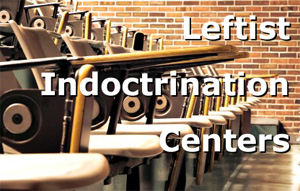 by Janice Shaw Crouse –
by Janice Shaw Crouse –
The best-kept secret in America today is the precipitous drop in the quality of college since the Left seized power in higher education. Every year, various magazines publish a list of rankings for American undergraduate institutions. Forbes assures parents that “Every school with a Forbes grade meets a high standard.” U.S. News and World Reportassures its readers that they consider a wide variety of factors in measuring a college’s effectiveness. While American colleges were once great institutions of learning, those who know higher education today recognize that “high standards” of quality are casualties in the war against traditionalism and American values. Where religion and love of country and family were once revered, radical Leftist ideology now prevails. Traditional values have been replaced by moral relativism, anti-establishment teachings, and the breakdown of the family.
The radicalization of colleges did not happen overnight. What we have now is a product of past indifference and disinclination to do anything to reverse the spread of Leftist trends. John Howard’s new book, America’s Best Colleges! Really?, lays out his analysis of how the traditional purpose of education has been eradicated and replaced by radical ideologies of the Left. Howard outlines a brief history of how our Founders desired our public education system to reinforce religion and morality in order for our self-reliant experiment to survive and thrive. In contrast, he points out how the Left has imbedded its teachings in America’s educational system and perverted the Founders’ original intent in order to undermine the country’s foundation.
Howard quotes ancient philosophers about the purpose and foundations of education. Aristotle: “Of all the things I have mentioned, that which contributes most to the permanence of constitutions is the adaption of education to the form of government.” Howard then states that “schooling is the foremost determinant of the well-being of a nation,” with the exceptions of religion and family. Howard cites Diogenes Laërtius who said, “The foundation of every state is the education of its youth.”
In one of the book’s most compelling stories, John Howard recounts a revealing meeting with government officials concerning educational objectives:
In 1963, a group of college presidents – I was among them – visited a number of members of Congress and officials from the Office of Education with a proposal to substitute tax credits for gifts to colleges in place of Federal grants. When we explained the plan to Dr. Francis Keppel, the U.S. Commissioner of Education, he said “We couldn’t allow that! It would prevent us from accomplishing our social objectives!” It was his intention to convert the educational institutions into agencies for achieving social objectives determined by the Federal government. Commissioner Keppel had just proven that the worst fears of what would happen to education if it were federalized, had already been fulfilled.”
So the federal government’s “social objectives” were paramount in the nation’s educational institutions. Certainly, the history of radicalization isn’t something that appeared out of nowhere. To anyone paying attention at the time, it was a steady pounding of extremist rhetoric and action in every aspect of the classroom.
Howard explains that during the 20th Century, extremists – such as Carl Rogers, Bill Ayers, Bruce Franklin, Herbert Marcuse, Charles Hurst Jr., Michael Klonsky, and Angela Davis – saw fertile ground on college and university campuses where they were able to infiltrate and produce a sea change in how Americans viewed their country, families, morality, and religion.
In addition, radical activism spread rapidly – college students increasingly identified with Che Guevara, Castro, Mao Tse Tung, Lenin, and Trotsky. Howard noted that “The Underground Press, virtually unknown to the public, exerted a wide and powerful influence on the youth of the 1960s and 1970s.” Indeed, radical publications grew from a handful in 1964 to over 400 in 1969 and more than 800 in 40 states in 1971.
Revolutionaries inevitably begin with an assault on religion.
Howard contends that morality is “the essential and irreplaceable foundation in a free society.” He then documents how everyone from Edmund Burke, President John Adams, President James Madison, and President John Quincy Adams, all declared political liberty can’t exist without morality. Howard believes that the “acculturation of the young for life in Christendom is carried on by religion, by the families, by educational institutions, by literature, and other cultural influences.” They then have to constantly be reinforced by the culture around them.
Revolutionaries inevitably begin with an assault on religion. The Wall Street Journal reported on July 5, 2002, that three quarters of all college seniors believe in moral relativity. An October 2012 Pew Research poll showed, “One-fifth of the U.S. public – and a third of adults under 30 – are religiously unaffiliated today, the highest percentages ever in Pew Research Center polling.” Because anti-American radicals have succeeded in undermining religion, standards of civil behavior have deteriorated, and our free society isn’t so free anymore.
Colleges and universities accept moral relativism as the intellectual standard.
Colleges and universities – even such high-prestige institutions as Princeton, Yale, and Harvard – accept moral relativism as the intellectual standard. This widely prevalent attitude was exemplified very early on by Dr. Lewis Mayhew in his address as the new president of the American Association of Higher Education in 1969: “Colleges are not churches, clinics or even parents. Whether or not a student burns a draft card, participates in a civil rights march, engages in pre-marital sexual activity, becomes pregnant, attends church, sleeps all day or drinks all night, is not really the concern of an educational institution.”
Political correctness, rejection of in loco parentis, and moral relativity are the new standards on campuses in both public and even private institutions, and the ramifications are staggering. Crime, drug use, cheating, money fraud, and a seemingly endless variety of licentious conduct are all accepted. This moral breakdown is producing no outrage from parents or the public. As long as parents demand nothing more from those who teach their children and those to whom they give their hard-earned money, nothing will change, except more erosion of values and more harm to young people.
Howard would like to see education restored to a place where it is seen as “helping the learners to come of age as a people, to conceive a good idea of themselves and to learn that the expression of the human spirit is most truly made in terms of wonder and delight. If education can move toward that ideal, it becomes its own abiding cause for optimism.” Man is “a thinking and feeling being,” a “social being,” and a “spiritual being.” Because of this premise, he asserts that our nation’s colleges should “seek to improve and refine the educational process” and design programs that “will be valid and vital for each generation of students.”
If higher education institutions would do that, there is hope for the future. … And, perhaps, America’s great institutions of the past will return to their former glory.
HT: American Thinker

